

Madhur Srivastava
Explorer | Traveler | Book Worm | Writer | Photographer
- Home
- Photography
- Travelogue
- Travel Diary
- Bookshelf
- Podcasts
- Words of Wisdom
- Articles
- Interviews
- Entertainment
- Amusing Stories
- Reviews
- Personal Finance
- Lifestyle
- In Desire
- Dropdown

Life is a waste of time, time is a waste of life
Get wasted all the time, and you will have time of your life
- Billy Connolly
Travel Diary
Experiences from Travel
Verschlimmbesserung
An effort to improve something that simply makes it worse
Destiny is the hard thing to run from
Yellowstone TV Series
←→Travelogue
In Tryst With Every Inch
Karlsruhe, Germany
Picture: Castle
Just across the border from the Rhine river lies a small college town of Karlsruhe. Sandwitched between Heidelberg in Germany and Strasbourg in France, Karlsruhe is unglamourous yet very attractive town. It is clean, residents are well dressed and there are plenty of young people, thanks to the Karlsruhe Institute of Technology. Surprisingly, everyone in the town is comfortable in speaking English, contrary to the general reputation of a German city. It seems to have everything one desires for peaceful and happy life. Plenty of nature, walkable city, lively city center, libraries, and friendly people. It is boutique town with elegance and quality of life of a large city.

Strasbourg, France
Picture: Train Station
While visiting for a conference in the city, a colleague suggested me to visit the European parliament. Little did he told the city itself is a world heritage site. Strasbourg embodies the life and times of the medieval age, barring all the violence and barbarism! The roads are narrow, canal encircles the city, shops closes early, ice creams are the tastiest, and every corner of the city is picturesque. All the roads lead to the famous (and huge) cathedral, which I believe is the envy of the other christian cities. Residents bike, walk, use Tram, and speak French. But many names in the city can sound German, as it is just a stone throw away from Germany, a former occupier of it.

Abu Dhabi, UAE
Picture: Sheikh Zayed Mosque
The future has been seen, it is Abu Dhabi. The UAE capital is epitomizes modernity in its fullest sense: beauty, architecture, infrastructure, culture, transportation and housing. It looks that the rulers of Abu Dhabi are determined to bring the world there. No cuisine unfound, no world-wide brands absent, and no nationality missing. Boasting of several tourist spots such as Lourve museum, it is the Zayed Mosque, the Aquarium and the Presidential Palace stands out beyond measure. The rulers not just have the wealth but also the taste for luxury and delicacies. While it is desert, it feels like none. It is easy find water everywhere, but almost impossible to spot a camel.

Bordeaux, France
Picture: Victoire Place
Bordeaux is not the city that comes to mind when someone says France; the honor usually goes to Paris or Nice. But this mini-Paris located next to the Atlantic ocean, is full of surprises and history. I was travelling to the city to visit a collaborator and never expected much, only to be proven wrong with the medieval architecture, night-lit city, wine region (including a museum dedicated to wine history), authentic food, and eye-catching scenery of river Garonne passing through the city. Not commonly known, even to French, that Bordeaux was part of British empire for some period, who converted it into wine region to avoid purchasing French wines! What an irony!
Podcasts
Currently Listening
Audiobook Listening
Novels -- Biography -- History
1Toshikazu Kawaguchi
Before the Coffee Gets Cold
Tales from the Cafe
Before Your Memory Fades
Before We Say Goodbye
Before We Forget Kindness
2Women Leaders
My Own Words (RBG)
Freedom (Angela Merkel)
Something Lost, Something Gained (Hillary Clinton)
The Art of Power (Nancy Pelosi)
A Different Kind of Power (Jacinda Ardern)
3Indian Partition
Partition Voices - Kavita Puri
Indian Summer
Freedom at Midnight
The Great Partition (Yasmin Khan)
Empireland - Sathnam Sanghera
4Chitra Banerjee Divakaruni
The Palace of Illusions
The Last Queen
Independence
The Forest of Enchantments
Before We Visit the Goddess
Oleander Girl
One Amazing Thing
Queen of Dreams
The Vine of Desire
The Unknown Errors of Our Lives
Sister of My Heart
The Mistress of Spices
Arranged Marriage
Book Series Reading: William Dalrymple
Reading: The Last Mughal
Read: The Golden Road; The Anarchy; Koh-i-noor.
To be Read: Return of a King; Nine Lives; White Mughals; City of Djinns; From the Holy Mountain; In Xanadu.










TV Series
In Desire of Next Season
1Panchayat
Season 1
Season 2
Season 3
Season 4
Season 5
2House of Dragons
Season 1
Season 2
Season 3
3Shogun
Season 1
Season 2
Bond Movie Series
Score: 3 out of 25



Reviews
Books and Cinema that touched me

Chernobyl - HBO TV Series
Truth is stranger than fiction. It is also unpredictable. While there have been many nuclear disasters, none have been like Chernobyl Nuclear Power Plant. It occurred at the peak of the cold war and could have destroyed a continent. The story of the disaster is essential to be told to the general public. What happened? How did it happen? How was it contained? And more importantly, what was the human cost? Both in terms of population effect and the people involved in the containment zone. There is no better way to tell the story than via cinema.
The 5-part TV series “Chernobyl” produced by HBO is a must watch masterpiece. It is bingeworthy. It is both suspenseful and factual. It covers the accident in detail, action taken by politicians (aka Soviet comrades) and role of scientists in determining the cause. The characters are real and the situation they face is unprecedented. Watching the series is like observing it in real time from a distant view. Whether it is the worry in the face of Mikhail Gorbachev, or the wife of a firefighter caring for her radiation infected husband, it is deeply personal. And deeply factual.
Killing of animals because they were contaminated is cruel and scientific at the same time. Ordered not by a politician but a scientist who cared for the future generation. The lives of people changed overnight, and they have to find a new home for the rest of their lives. An old woman who didn't leave her village since birth, despite living the fears of the two world wars, Nazi occupation and Soviet capture, had to succumb to the radiation to find a new home.
And finally, the culprit: Was it a human error or the faulty rods? While the TV series ends blaming the system and faulty rods, the answer is more profound. Shouldn't scientists consider human error when designing a reactor? Especially when the stake is high, like in the case of a nuclear power plant. These are the questions one is left wondering at the end of the series. And the thing that makes it so real and thought-provoking are the characters and the actors portraying them. I am glad that HBO made the TV series and I watched it.

Edible Economics
While all economists are wrong, someare useful and entertaining. Such is the case with the book "Edible Economics". It gives a primer of various economic concepts and justifies them with selective facts. However, the justification is well-reasoned and respectable. Coming from a left leaning perspective, it favors government intervention, and at the current time of high inflation, the arguments does seem compelling.
More than the topics, it is theauthor Ha-Joon Chang and how he narrates each story is where the fascination of the book lies. Picking an edible vegetable, fruit or condiment, the author describes its history and its relation to a culture; sometimes its commercial value and trade association. One learns a lot about these edible items and subsequently an economic trait or policy that resembles a similar life.
Who thought that term "Banana Republic" is actually linked to banana trade in the Central and South America. Or strawberry is not a berry, but tomato is! Chicken is neither loved or hated, but still is omnipresent, revealing the sustainable power of remaining non-controversial. Or varieties of noodles and pastas that are unheard of; going viral doesn't seem to be their strong suit!
The stories are narrated in shortchapters, which makes the book easily readable and a definite page turner. One may not agree with each economic argument presented, but it definitely provides food for thought!
A person unfamiliar with basiceconomics will find it useful for gaining valuable insights with nice anecdotes. One may also surprise friends and family with newly gained knowledge, especially if one doesn't currently belong to the elite club of economic discourse at the family table.
© 2024
































